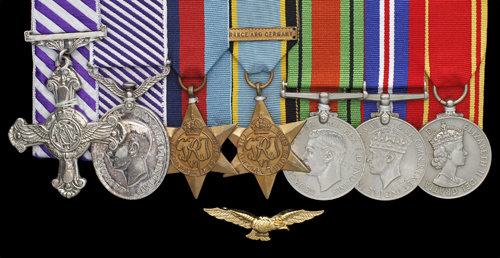
Auction: 1008 - Orders, Decorations, Campaign Medals & Militaria
Lot: 18
Family Group: A Second War 1944 ´Pathfinder´s´ D.F.C., D.F.M. Group of Seven to Flight Engineering Leader, Flight Lieutenant G. Robinson, Royal Air Force, Who Flew in at Least 60 Operational Sorties in Stirlings and Lancasters, Mainly Over Heavily Defended German Targets, Including to Five Times to Berlin a) Distinguished Flying Cross, G.VI.R., reverse officially dated ´1944´ b) Distinguished Flying Medal, G.VI.R. (628021 F/Sgt. G. Robinson. R.A.F.) c) 1939-1945 Star d) Air Crew Europe Star, with France and Germany Bar e) Defence and War Medals f) Fire Brigade Long Service Medal (Stn. Offr. Garner Robinson), generally very fine, mounted as originally worn, with the following related items: - D.F.C. Royal Mint case of issue - St. John Ambulance Association Badge, engraved ´A 221920 Garner Robinson´ - The recipient´s riband bar - Path Finder Force Badge Award Certificate, dated 14.6.1943, with Path Finder Force Badge, in gilt metal - Buckingham Palace Investiture Admittance Ticket, dated 12.10.1943 - Certificate of Recognition of Support of the Bomber Command Museum Appeal - Three photographs of recipient in uniform, two photographic images, and a number of newspaper cuttings Three: Farrier Sergeant J.R. Robinson, Royal Artillery 1914-15 Star (44766 Far: Sjt. J.R. Robinson. R.F.A.); British War and Victory Medals (44766 Sjt. J.R. Robinson. R.A.), generally very fine, with Royal Artillery shoulder title; Princess Mary´s Christmas tin; and a photographic image of recipient (lot) Estimate £ 4,000-4,500 D.F.C. London Gazette 14.11.1944 A/Flt. Lt. Garner Robinson, D.F.M. (53730), 83 Sqn, R.A.F. The Recommendation states: ´Since being awarded the Distinguished Flying Medal in March 1943, this Officer has completed further sorties with this Squadron. He now has a total of 60 operational flights to his credit. At all times he has proved himself to be cool and courageous in the face of the enemy´s defences and has set a sterling example as Flight Engineer Leader of the Squadron. On the night of 26th July, 1944, as Engineer to the Controller of an attack on Givors, the route over the enemy occupied territory to the target was covered by heavy thunderstorms and the aircraft suffered severe icing. These difficult flying conditions were also encountered over the target and prevented the normal marking procedure being brought into affect. Displaying great coolness and efficiency, Flight Lieutenant Robinson pin-pointed the position of the aircraft despite the difficult conditions and skilfully guided his captain to the aiming point. His undaunted determination and skill on this occasion of almost hopeless conditions of weather and in face of enemy opposition, enabled the marking to be completed accurately and the raid to be a success. Flight Lieutenant Robinson has always displayed outstanding morale and determination which have been an inspiration to all Flight Engineers in the Squadron and he is strongly recommended for the award of the Distinguished Flying Cross.´ D.F.M. London Gazette 14.3.1943 Flight Sergeant Garner Robinson (628021), 7 Squadron The Recommendation states: ´This Flight Engineer has now completed 30 operational sorties against well defended targets in Germany and other distant objectives. He has proved himself to be an excellent Flight Engineer, and he has always carried out his duties in a most efficient manner. His keenness for operational flying is outstanding and his encouragement to younger engineers is most praiseworthy.´ Covering Remarks of Officer Commanding, Path Finder Force: ´This N.C.O. has at all times carried out his duties in a highly commendable manner and has always been conscientious in his work and unceasingly anxious to operate against the enemy.´ Flight Lieutenant Garner Robinson, D.F.C., D.F.M. (1921-2005), born Rotherham, Yorkshire, the son of John Richard Robinson; joined the Royal Air Force, November 1938; underwent initial training at Upwood, Henlow and St. Athen before qualifying as a flight mechanic, Aircraftman 1st Class, November 1939; throughout 1940 he was employed maintaining aircraft at R.A.F. West Freugh, Scotland and then to Silloth Coastal Command O.T.U.; anxious to be involved in operational sorties he volunteered for aircrew training in September 1941; posted for operational flying as Flight Engineer 7 (Path Finder Force) Squadron (Stirlings), Oakington, May 1942; in his first operational tour, which started on 7.7.1942, he flew in 30 sorties with the squadron, including: Wilhelmshaven; Duisberg (4); Hamburg; Saarbrucken; Dusseldorf (2); Osnabruck (3), including 17.8.1942 (his first Path Finder Force sortie); Flensburg; Frankfurt; Kassel; Nurenburg; Krefeld; Cologne; Genoa; Turin (6); Mannheim and Munich; posted for instructional duties, after which he briefly returned as Pilot Officer to 7 Squadron before being posted as Flight Lieutenant, Flight Engineering Leader, 83 (Path Finder Force) Squadron (Lancasters), Wyton; between 31.1.1943 - 26.7.1944, he flew in a further 32 operational sorties, including: Hamburg (2); Cologne (2); Turin; Wilhelmshaven (3); Bremen; Nurenburg; Munich; Stuttgart (2); Berlin (5); Kiel; Frankfurt (2); Wuppertal; Brunswick; Magdeburg; Ausburg; Schweinfurt; Bordeaux; Toulouse; Paris; Odon; Villeneuve and Givors; discharged from the Royal Air Force, July 1946; after the War joined the Fire Service in Boston, Lincolnshire, 23.3.1949; after 32 years and 90 days service with the force he retired with the rank of Assistant Divisional Officer; moved to Cyprus in 2005, where he spent the remainder of his life. He is buried in the British Cemetery, Kolossi, Cyprus. 44766 Farrier Sergeant John Richard Robinson (1888-1930), born at the Wheat Sheaf Public House, Gravesborough, South Yorkshire, the son of the landlord John White Robinson; served as a groom for the Hunts at Nostell Priory and Heath Common, Leicestershire before service during the Great War.
Sold for
£4,500




